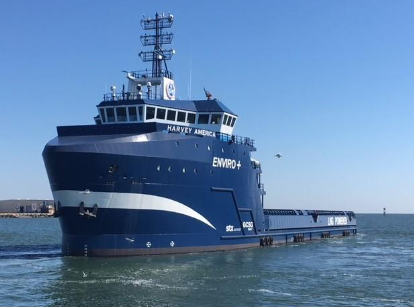Yesterday, Harvey Gulf International Marine announced that it has begun to operate one of its tri-fuel vessels exclusively on battery power and renewable liquefied natural gas (RLNG), with diesel fuel as backup, moving one step closer to becoming the world's first ESG-certified (environmental, social and governance) oil and gas vessel operator.
RLNG is recaptured swine and dairy farm gas from pigs and cows. The use of RLNG enables clients who charter the company's dual and tri-fueled RLNG vessels to obtain a Carbon Neutral Certificate for their related vessel operations.
"We always knew the day would come when investors and customers would demand low, or in this case, carbon-neutral, zero-emission Platform Supply Vessels,” CEO Shane Guidry said in a statement. “Harvey owns the only ones in the world operating today and the only ones that will ever be operating in the United States, unless our competitors want to build new dual-fuel LNG vessels, or tri-fueled like these at a cost of $113 million per vessel.
"I don’t see that happening, as you will never get a day rate from the end user that will support the $113 million construction cost," Guidry contiued. "Today, we own five 310' platform supply vessels all of which can operate carbon neutral utilizing renewable liquefied natural gas. So, for those oil companies that really want to do all they can to reduce emissions while drilling for oil, we have boats that they can now charter to deliver the drilling rigs' needs while burning carbon-neutral fuel."
The carbon neutral RLNG being consumed onboard is a blend of low carbon intensity (CI) sourced bio-methane from the swine and bovine industries. The natural methane produced from the waste/byproduct of the pork and dairy sectors is recovered via digesters. The processing of the waste and extracting of the methane results in negative carbon intensity (CI) scored renewable gas.
Through blending at Harvey Gulf’s LNG fueling terminal (the only one in the U.S.) the company can achieve net-zero carbon-neutral fuel burn whereby low CI score RLNG is blended with locally available LNG, HGIM said. An example would be blending local sourced LNG with a CI score of +80LNG with RLNG with a CI score of -440, the net-zero blend would be at a ratio of 5.5:1.
Through these types of innovative thought processes, the company is able to continue to support its clients in meeting their environmental commitments, he added.
Harvey Gulf also announced that it has ordered 25 electric trucks for its employee fleet. All will replace existing combustion engine vehicles and be used to support the company's vessel operations and efforts to continue down the de-carbonization path.




